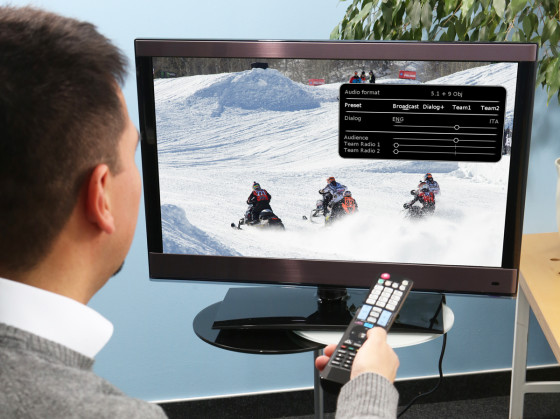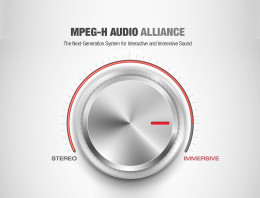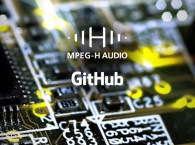
Meanwhile, several audio companies are working with Fraunhofer IIS to implement support to MPEG-H in new and existing products.
British company Calrec, implemented support for MPEG-H in its mixing console range used in the world’s first live broadcast demonstration of interactive and immersive TV audio at the 2015 National Association of Broadcasters (NAB) Show in Las Vegas, NV. Another example of interest comes from German company Jünger Audio, which introduced an MPEG-H audio monitoring and authoring unit (still in prototype) to power the NAB 2015 demonstrations.
MPEG-H Audio offers viewers the ability to turn up or down particular audio elements in a program – such as dialogue or sound effects – as they prefer, as well as the ability to choose different audio presentations, such as “home team” or “away team” commentary for a sports event. Additionally, it is a true multi-screen audio system that tailors playback so programs sound best on a range of devices and environments – from quiet home theaters with speakers to the subway or airport with earbuds.
The system is based on the new MPEG-H Audio international standard and was designed to offer broadcasters a cost-effective means to elevate the sound quality of their offerings beyond 5.1 surround while incorporating groundbreaking new interactive and immersive features across the full range of modern viewing devices from high-end home theaters, to tablets, smartphones, and sound bars.
Fraunhofer IIS, Qualcomm Technologies and Technicolor are the three major technology companies behind the MPEG-H Audio standard and the MPEG-H Audio Alliance. During the NAB Show in Las Vegas, the system was demonstrated in both the Fraunhofer booth and the Qualcomm booth.
The end-to-end live production demonstration at the Fraunhofer booth incorporated a live audio feed from a remote truck combined with recorded programming from video servers at the network. The demo included the process for distributing the new, live content to affiliate stations, inserting local commercials and emission to viewers’ living rooms.
Aside from the Fraunhofer prototype audio/video encoders and decoders and the new Jünger Audio monitoring unit, all of the equipment in the demonstration was unmodified broadcast equipment used in TV plants and remote trucks today. Visitors were also able to experience immersive sound over loudspeakers, new 3D soundbars, tablet computer speakers, and headphones. The demonstration also included prototypes of new consumer devices supporting MPEG-H, including a Technicolor set-top box, a Samsung pre-production prototype TV, and a Texas Instruments-based audio-video receiver.

All the MPEG-H features will be under the control of the broadcaster or content distributor, providing new creative opportunities, such as the ability to efficiently add additional languages, players, or official microphones, or, as the three companies have demonstrated at NAB 2015, car to pit crew radios at races.
“This system has grown from our pioneering work on Dialogue Enhancement years ago and our early work in immersive sound, as well as our 15 years of providing half the world’s TV sound. In November 2013, we presented the idea of a football game where you could “Hear Your Home Team” and adjust audio elements of a program to your preference. We have progressed to a full, live implementation of the audio path from the field of play at a sports event to the listener’s ears at home or mobile,” said Robert Bleidt, Division General Manager at Fraunhofer USA Digital Media Technologies.
“At Technicolor we are proud to contribute our Scene Based Audio Higher-Order Ambisonics (HOA) technology to this great opportunity for broadcasters,” said Claude Gagnon, SVP, Content Solutions & Industry Relations. “We continue to invest in the creative community to develop a rich ecosystem for the Film and the Broadcast industry.”
MPEG-H Over 7 PCM channels
During the 2015 NAB Show, Qualcomm Technologies also demonstrated an end-to-end simulated live broadcast of immersive, scene-based MPEG-H audio, including every stage of a live Higher Order Ambisonic (HOA) production, from capture of a live 3D musical performance, through efficient transport through a TV plant (NoC to affiliate), an emission encoder (MPEG-H) to playback on consumer devices with various speaker configurations.
“Qualcomm Technologies collaborated on the development and supports the new MPEG-H standard, and is taking important steps towards widespread distribution of HOA and MPEG-H audio across a range of consumer devices,” said Samir Gupta, Vice President, Engineering, Qualcomm Technologies. “Given Qualcomm Technologies’ technology leadership in 4K UHD video and now with MPEG-H audio, Qualcomm Technologies continues to drive innovations that can deliver unprecedented mobile multimedia experiences to consumers.”

Calrec and Jünger Audio
Integral to the MPEG-H Audio Alliance demonstration at the Fraunhofer NAB booth, Calrec did a live mixing session of an extreme sports event from a major network using the Calrec Artemis console.
Fraunhofer IIS was present at the sports event and recorded all of the microphone signals and video feeds, as well as some additional microphones placed for immersive ambience. The recorded signals were played back through the Calrec console and mixed live during the show by the Alliance’s A1 Jim Hilson and sound designer Dennis Baxter.
According to Calrec, today’s consoles can easily be adapted for MPEG-H Audio broadcasts with accessory equipment to provide monitor control, downmixing, and loudness metering for the new audio system’s additional height channels and audio objects. For this demonstration, these features were provided by a Jünger Audio MPEG-H Audio Monitoring and Authoring Unit connected to the console’s MADI outputs.
“We are pleased to work with Calrec on this demonstration since their consoles are in the majority of remote trucks used for U.S. broadcasts. Our A1’s are familiar with them, and we had the console interfaced to the Jünger unit and on the air in a few hours,” said Robert Bleidt, Division General Manager at Fraunhofer USA Digital Media Technologies.
The demonstration featured three static audio objects for commentary, to allow the viewer to switch between the network commentary, venue PA commentary, and a foreign language commentary. Sound effects from the event were also panned using MPEG-H Audio’s dynamic audio objects.
The Jünger Audio MPEG-H Audio Monitoring and Authoring Unit used in the demonstration allowed all MPEG-H Audio modes and configurations to be monitored, including simulation of the operation of consumer receivers for interactive elements. Loudness of each presentation or preset mix in an interactive program was displayed on the unit’s remote control panel and web interface.
The unit also includes the tools needed to mix and author content in immersive sound, to add audio objects for interactivity, and to pan dynamic audio objects. Existing 5.1 surround audio consoles can be upgraded by simply connecting the Jünger Audio Unit.
MPEG-H Audio signals in production and contribution are intended to be embedded in standard HD-SDI video signals or MADI audio signals as uncompressed PCM audio. As such, MPEG-H Audio broadcasts can be confidently monitored using the standard HD-SDI monitor panels broadcasters use today, and production can be done using today’s 5.1 consoles and monitors.
To completely monitor broadcasts using the advanced features of MPEG-H Audio, several additional functions must be provided:
• Audio objects must be rendered to the speaker configuration being used and combined with the main program bed.
• The speaker configuration may include height channels for immersive sound, so a monitor controller for up to 12 speakers must be provided.
• Loudness metering for programs with immersive sound or audio objects must be provided.
• Audio presentation presets sent to consumer receivers must be checked for proper authoring, content, and mixing.
• Monitoring of downmixes that duplicate those in consumer receivers must be possible.
• Monitoring of Dynamic Range Profiles must be provided.
• Content in the Higher-Order Ambisonics mode of MPEG-H Audio must be rendered to the speaker configuration being used.
The Jünger Audio MPEG-H Audio Monitoring and Authoring Unit provided all those functions.
Authoring MPEG-H Audio:
To produce advanced MPEG-H Audio broadcasts, the following tools will be needed to create the additional elements:
• Static audio objects must have their position and default levels specified, and names assigned for those objects exposed to the consumer.
• Additionally, dynamic audio objects must be able to be panned during live or post-produced broadcasts.
• Audio object groups and presentations must be named and specified.
• Dynamic range profile settings, downmix gains, and the target loudness level of the program specified, if desired by the broadcaster.
For broadcasts using dynamic objects, the Jünger Audio MPEG-H Audio Monitoring and Authoring Unit creates an MPEG-H Audio control track containing the panning data that may be carried with the audio signals over embedded HD-SDI or MADI. The Audio Monitoring and Authoring Unit also encodes the other static metadata above in the control track, so that all the information needed to prepare a show can be entered directly in the unit.
The control track is only needed to take advantage of MPEG-H Audio’s dynamic audio objects or for agile loudness control or channel assignment. Broadcasters may continue to use a fixed loudness level and channel assignment as they do today without the need for control track information. In this case, configuration information may be entered in the MPEG-H Audio encoder.
www.qualcomm.com/mpegh-scene-based-audio
www.technicolor.com
www.iis.fraunhofer.de/audio






